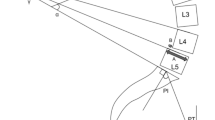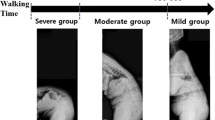Abstract
Lumbar stenosis is frequently observed and treated by spine surgeons. The extent of neurological decompression and the potential spinal fixation are the basic concerns when surgery is planned. But this segmented approach to the problem is sometimes insufficient due to the complex functional situations induced by a sagittal imbalance of the patient and the combination of pathologies known as hip-spine or knee-spine syndromes. A total of 373 consecutive patients included from our EOS and clinical data base. Patients were divided in two groups. Group A included patients presenting exclusive spinal issues (172 cases) out of whom 117 (68 %) had sagittal imbalance. Among 201 patients with associated lower limbs issues (group B), 122 (61 %) had sagittal imbalance. The perception of imbalance was noticed in 54 % (93 cases) in group A and 57 % (115 cases) in group B. In the global series of 239 imbalanced cases, the key point was a spine issue for 165 patients (the 117 patients with only spine problems and 48/122 cases with combined spine and lower limbs problems). But in the patients with combined spine and lower limbs problems, we individualized hip-spine syndromes (24/122 patients) and knee-spine syndromes (13/122 patients). In some cases, (37/122 patients) the anatomical and functional situations were more complex to characterize a spine-hip or a hip-spine problem. The EOS full-body images provide new information regarding the global spinal and lower limbs alignment to improve the understanding of the patient functional posture. This study highlights the importance of the lower limb evaluation not only as compensatory mechanism of the spinal problems but also as an individualized parameter with its own influence on the global balance analysis.
Level of evidence IV diagnostic case series.
















Similar content being viewed by others
References
Vialle R, Levassor N, Rillardon L et al (2005) Radiographic analysis of the sagittal alignment and balance of the spine in asymptomatic subjects. J Bone Joint Surg Am 87:260–267
Roussouly P, Gollogly S, Berthonnaud E, Dimnet J (2005) Classification of the normal variation in the sagittal alignment of the human lumbar spine and pelvis in the standing position. Spine (Phila Pa 1976) 30(3):346–353
Vaz G, Roussouly P, Berthonnaud E et al (2002) Sagittal morphology and equilibrium of pelvis and spine. Eur Spine J 11:80–88
Barrey C, Roussouly P, Le Huec JC, D’Acunzi G, Perrin G (2013) Compensatory mechanisms contributing to keep the sagittal balance of the spine. Eur Spine J 22(Suppl 6):S834–S841
Boulay C, Tardieu C, Hecquet J et al (2006) Sagittal alignment of spine and pelvis regulated by pelvic incidence: standard values and prediction of lordosis. Eur Spine J 15:415–422
Barrey C, Jund J, Noseda O et al (2007) Sagittal balance of the pelvis-spine complex and lumbar degenerative diseases. A comparative study about 85 cases. Eur Spine J 16:1459–1467
Funao H, Tsuji T, Hosogane N, Watanabe K, Ishii K, Nakamura M, Chiba K, Toyama Y, Matsumoto M (2012) Comparative study of spinopelvic sagittal alignment between patients with and without degenerative spondylolisthesis. Eur Spine J 21(11):2181–2187
Hammerberg EM, Wood KB (2003) Sagittal profile of the elderly. J Spinal Disord 16:44–50
Mac-Thiong JM, Roussouly P, Berthonnaud E, Guigui P (2011) Age- and sex-related variations in sagittal sacropelvic morphology and balance in asymptomatic adults. Eur Spine J 20(Suppl 5):572–577
Iyer S, Lenke LG, Nemani VM, Albert TJ, Sides BA, Metz LN, Cunningham ME, Kim HJ (2016) Variations in sagittal alignment parameters based on age: a prospective study of asymptomatic volunteers using full-body radiographs. Spine (Phila Pa 1976) [Epub ahead of print]
Murata Y, Takahashi K, Yamagata M, Hanaoka E, Moriya H (2003) The knee-spine syndrome. Association between lumbar lordosis and extension of the knee. J Bone Joint Surg (Br) 85-B:95–99
Ben-Galim P, Ben-Galim T, Rand N, Haim A, Hipp J, Dekel S, Floman Y (2007) Hip-spine syndrome: the effect of total hip replacement surgery on low back pain in severe osteoarthritis of the hip. Spine (Phila Pa 1976) 32(19):2099–2102
Obeid I, Hauger O, Aunoble S et al (2011) Global analysis of sagittal spinal alignment in major deformities: correlation between lack of lumbar lordosis and flexion of the knee. Eur Spine J 20(Suppl 5):681–685
Devin CJ, McCullough KA, Morris BJ, Yates AJ, Kang JD (2012) Hip-spine syndrome. J Am Acad Orthop Surg 20(7):434–442
Lee SM, Yoon MG, Moon MS et al (2013) Effect of correction of the contractured flexed osteoarthritic knee on the sagittal alignment by total replacement. Asian Spine J 7:204–211
Lee CS, Park SJ, Chung SS, Lee KH (2013) The effect of simulated knee flexion on sagittal spinal alignment: novel interpretation of spinopelvic alignment. Eur Spine J 22(5):1059–1065
Weng WJ, Wang WJ, Wu MD, Xu ZH, Xu LL, Qiu Y (2015) Characteristics of sagittal spine-pelvis-leg alignment in patients with severe hip osteoarthritis. Eur Spine J 24(6):1228–1236
Tauchi R, Imagama S, Muramoto A, Tsuboi M, Ishiguro N, Hasegawa Y (2015) Influence of spinal imbalance on knee osteoarthritis in community-living elderly adults. Nagoya J Med Sci 77(3):329–337
Wang WJ, Liu F, Zhu YW, Sun MH, Qiu Y, Weng WJ (2016) Sagittal alignment of the spine-pelvis-lower extremity axis in patients with severe knee osteoarthritis: a radiographic study. Bone Joint Res 5(5):198–205
Lazennec JY, Brusson A, Rousseau MA (2011) Hip-spine relations and sagittal balance clinical consequences. Eur Spine J 20(Suppl 5):686–698
Banno T, Togawa D, Arima H, Hasegawa T, Yamato Y, Kobayashi S, Yasuda T, Oe S, Hoshino H, Matsuyama Y (2016) The cohort study for the determination of reference values for spinopelvic parameters (T1 pelvic angle and global tilt) in elderly volunteers. Eur Spine J. doi:10.1007/s00586-016-4411-x
Lazennec JY, Rousseau MA, Brusson A, Folinais D, Amel M, Clarke I, Pour AE (2015) Total hip prostheses in standing, sitting and squatting positions: an overview of our 8 years practice using the EOS imaging technology. Open Orthop J 9:26–44
Roussouly P, Nnadi C (2010) Sagittal plane deformity: an overview of interpretation and management. Eur Spine J 9:1824–1836
Obeid I, Boissière L, Yilgor C, Larrieu D, Pellisé F, Alanay A, Acaroglu E, Perez-Grueso FJ, Kleinstück F, Vital JM, Bourghli A; European Spine Study Group, ESSG (2016) Global tilt: a single parameter incorporating spinal and pelvic sagittal parameters and least affected by patient positioning. Eur Spine J. doi:10.1007/s00586-016-4649-3
Le Huec JC, Charosky S, Barrey C, Rigal J, Aunoble S (2011) Sagittal imbalance cascade for simple degenerative spine and consequences: algorithm of decision for appropriate treatment. Eur Spine J 20(Suppl 5):699–703
Lazennec JY, Brusson A, Folinais D, Zhang A, Pour AE, Rousseau MA (2015) Measuring extension of the lumbar-pelvic-femoral complex with the EOS® system. Eur J Orthop Surg Traumatol 25(6):1061–1068
Lazennec JY, Brusson A, Rousseau MA (2013) Lumbar-pelvic-femoral balance on sitting and standing lateral radiographs. Orthop Traumatol Surg Res 99(1 Suppl):S87–S103
Than P, Szuper K, Somoskeöy S, Warta V, Illés T (2012) Geometrical values of the normal and arthritic hip and knee detected with the EOS imaging system. Int Orthop 36(6):1291–1297. doi:10.1007/s00264
Glassman SD, Bridwell K, Dimar JR, Horton W, Berven S, Schwab F (2005) The impact of positive sagittal balance in adult spinal deformity. Spine (Phila Pa 1976) 30(18):2024–2029
Author information
Authors and Affiliations
Corresponding author
Ethics declarations
Conflict of interest
None.
Ethical approval
All procedures performed in studies involving human participants were in accordance with the ethical standards of the institutional and/or national research committee and with the 1964 Helsinki Declaration and its later amendments or comparable ethical standards.
Informed consent
Informed consent was obtained from all individual participants included in the study.
Rights and permissions
About this article
Cite this article
Lazennec, J.Y., Folinais, D., Bendaya, S. et al. The global alignment in patients with lumbar spinal stenosis: our experience using the EOS full-body images. Eur J Orthop Surg Traumatol 26, 713–724 (2016). https://doi.org/10.1007/s00590-016-1833-4
Received:
Accepted:
Published:
Issue Date:
DOI: https://doi.org/10.1007/s00590-016-1833-4




